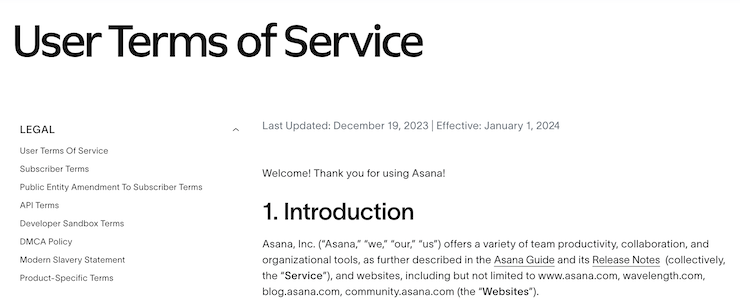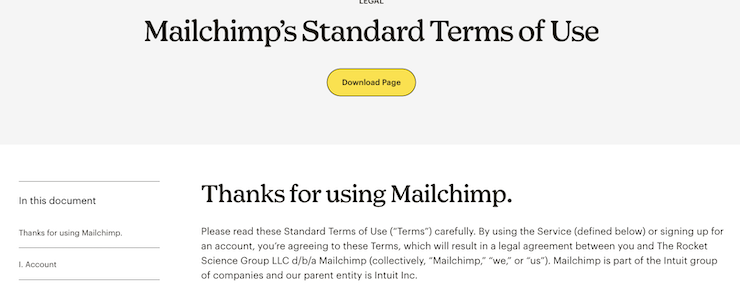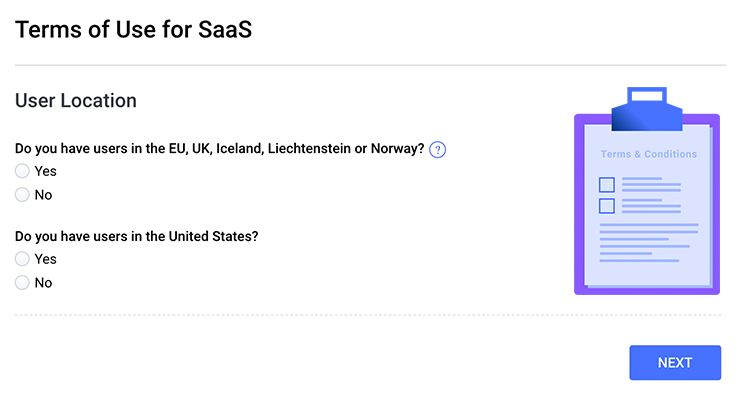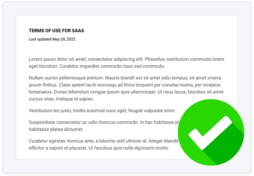If you offer software-as-a-service (SaaS) products, you need a SaaS agreement or contract that lets users know how they can and cannot interact with your service.
A SaaS agreement is like a terms of use for subscription sites, apps, and services.
Below, I describe what a SaaS agreement is, provide some examples, and give you a handy checklist to help you address everything that must be included in your contract.
What Is a SaaS Agreement?
A SaaS agreement is a legal contract between an application’s developers and its users that lays out the terms and conditions regarding how the SaaS application is accessed and used.
SaaS contracts usually include a:
- License agreement
- Reseller agreement
- Subscription agreement
- Any other service-level agreements
For example, service-level agreements usually define the level of service a customer can expect from the SaaS provider, the metrics by which these expectations are monitored, and any remedies that will be carried out if these service levels are not adequately met.
Many SaaS providers have a terms of service or terms and conditions page, which serves as their SaaS agreement.
This is usually the same a simple SaaS agreement but under different names, as terms and conditions are so versatile.
Do I Need a SaaS Agreement?
Yes, you need a SaaS agreement if you’re delivering software and data from a central location that your customers access through the internet, rather than providing a local download or installation.
This is typically done through a subscription model in which the customer:
- Will not receive a physical or downloadable copy of the software
- Will not have any ownership in the SaaS application
- Will forfeit the right to access and use the application if the SaaS agreement is terminated
Having a SaaS agreement helps you outline rules of download and use when accessing your service, protecting your interests and establishing documentation in the event of a user dispute.
SaaS Agreement Examples
Let’s look at how other companies lay out the terms and conditions for their services.
Asana Terms of Service
To start, let’s look at Asana’s terms of service which doubles as their SaaS agreement.

Asana is a good example because, before diving into the terms themselves, the document lays out a few definitions intended to help the reader comprehend the terms more fully.
Most SaaS agreements should include a section like this.
After defining key concepts and terminology, Asana also includes a disclaimer alerting readers to the possibility of updates and changes to its Terms.
Including this disclaimer makes it the user’s responsibility to remain aware of the Terms. If they can’t comply with any modifications, they’re urged to stop using Asana’s Service.
Mailchimp’s Terms of Use
Next, let’s look at Mailchimp’s Standard Terms of Use, which contains sections grouped under six categories, including Account, Payment, Rights, Rules and Abuse, Liability, and Other Important Stuff.

Like Asana, Mailchimp lays out key definitions before delving into the Terms.
For example, it defines its “Service” as a collective reference to the App (defined as the online marketing platform provided) and the Mailchimp Site.
Another helpful feature on Mailchimp’s Terms page is a sidebar that allows readers to navigate the six overarching sections of the agreement.
You can create agreements like the examples above using Termly’s free SaaS agreement generator.
SaaS Agreement Checklist
While SaaS agreements will vary according to your business and product offering, some elements are crucial to include in any SaaS contract.
Here’s a checklist to help you simplify making one of these agreements for your site:
- Step One – Include Start and End Dates: The start date — also known as the effective date or the commencement date — is the date that your SaaS subscription agreement officially goes into effect and the subscription becomes available for use to the customer.
- Step Two – Address Billing and Payments: Payment terms inform users about how much they need to pay, when, and how. This section addresses how often billing will occur for a SaaS subscription. Most subscriptions offer monthly, annual, or one-time purchase options. Semi-annual and multi-year billing are also possibilities.
- Step Three – Add Licensing Terms: SaaS providers will assign a customer a license to use the service upon purchase. Large-scale SaaS purchases usually include an assigned number of licenses that can be distributed throughout an organization. SaaS licensing agreements must be drafted such that the license is for the service(s) provided, not the software. Providing licenses for the software risks users reverse engineering your product and profiting off your hard work. A robust SaaS end user license agreement will help you avoid such risks.
- Step Four – Disclaim Any Warranties: You must specify whether you include or disclaim any warranties. For example, you might offer a general warranty concerning satisfactory services while mentioning that there’s no guarantee your application will be error-free at all times and refusing to take responsibility for misuse of your services.
- Step Five – Privacy Considerations: While you can include privacy terms in your SaaS agreement, you must comply with the California Online Privacy Protection Act (CalOPPA) if you’re doing business in the United States. This makes it obligatory to include the word “privacy” in the agreement. As a result, many companies choose to provide a separate privacy policy. For example, Mailchimp includes a brief section titled “Privacy Policy” in its Terms of Use but has a separate, more detailed policy page as well.
- Step Six – Other SLA Terms: A SaaS service-level agreement (SLA) lays out the specific services provided as well as rules for using them. It includes support services, software maintenance services, and terms regarding the hosting of SaaS software and data. A SaaS service agreement might also outline remedies or penalties for downtime, such as monetary compensation or measures taken to limit damage to users.
Create Your SaaS Agreement Now
Create Your Free SaaS Agreement Using Termly
Here’s how you can use Termly’s generator to create comprehensive and customized SaaS agreement.
Step 1: Go to Termly’s terms of use for SaaS generator.
Step 2: Answer a few simple prompts and questions, and go through all of the steps until you reach “Final Details.”

Step 3: Once you’ve filled in everything and you are satisfied with the preview, click “Publish.” You will then be prompted to create an account on Termly so you can save and edit your terms and conditions further.
To create an agreement between your site, service, or app and its users, use our free terms of use generator to publish a custom policy in minutes.


